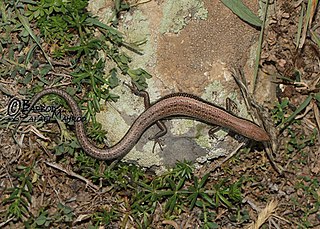
Ablepharus is a genus of skinks that contains the common snake-eyed skinks. Both their scientific and common names refer to the fact that their eyelids have fused to a translucent capsule; as in snakes, they thus are physically incapable of blinking. They are small lizards and prefer to live in the leaf litter of dry fields and hills. Their scales give them a very shiny, bronze appearance with a characteristically dark stripe down the sides of their bodies. They prey on small insects and other small mollusks.
The minor snake-eyed skink is a species of lizard in the family Scincidae. The species is native to Asia.

The Asian snake-eyed skink is a species of skink. It is found in Georgia, southern Turkmenistan, southern Tajikistan, Uzbekistan, Kyrgyzstan, western Azerbaijan, eastern Iran, Iraq, Oman, Afghanistan, Pakistan, Jordan, Syria, the United Arab Emirates, northwestern India, and Cyprus.
Ablepharus ladacensis, also known as the Ladak ground skink, is a species of skink found in Tibet (China), North India, western Nepal, and northern Pakistan.

Ablepharus kitaibelii, also known commonly as the European copper skink, the European snake-eyed skink, the juniper skink, and the snake-eyed skink, is a species of skink, a lizard in the subfamily Eugongylinae of the family Scincidae. The species is native to Eastern Europe and Southwestern Asia.
Ablepharus sikimmensis is a species of skink found in Bangladesh (Rangpur), Bhutan, China (Tibet), India and Nepal.

Eptesicus is a genus of bats, commonly called house bats or serotine bats, in the family Vespertilionidae. The genus name is likely derived from the Greek words ptetikos 'able to fly' or petomai 'house flier', although this is not certain.

Ablepharus budaki, commonly known as Budak's skink and Budak's snake-eyed skink, is a species of lizard in the family Scincidae. The species is endemic to the Near East.

Ablepharus rueppellii, known commonly as Rüppell's snake-eyed skink, is a species of skink found in the Middle East. It was formerly considered a subspecies of Ablepharus kitaibelii, but has since been distinguished. What is currently recognized as this species is possibly two distinct species.
The Anatolian vole is a species of vole found in Turkey, specifically Konya Province. The population is unknown but it lives in small colonies. The species exists in an area that is a remnant zone of Tethys Ocean, and this area is being increasingly exploited for sugar beet cultivation. Other related threats include irrigation and rodenticides from the sugar beet cultivation. The eastern range may be protected by Lake Tuz Special Protected Area but this area is not well protected and has been deteriorated.

The twin-striped skink is a skink native to Armenia, Azerbaijan, Turkmenistan, northwestern Iran and Turkey. It is generally found at elevations between 2,300 metres (7,500 ft) and 3,300 metres (10,800 ft).

Chernov's skink is a species of skink, a lizard in the family Scincidae. The species is endemic to northern Eurasia.
Ablepharus darvazi, also known as Darvaz snake-eyed skink, is a species of skink, a lizard in the family Scincidae. The species is endemic to Central Asia.

The desert lidless skink is a species of skink native to southern Kazakhstan, Kyrgyzstan, northern Tajikistan, Uzbekistan and eastern Turkmenistan.
The animal name changes in Turkey is the revision of taxonomic nomenclature of three subspecies by the Turkish Ministry of Environment and Forestry. The name changes removed references to Armenia and Kurdistan in the taxonomic nomenclature of subspecies of each animal.
Richard Sternfeld was a German-Jewish herpetologist, who was responsible for describing over forty species of amphibians and reptiles, particularly from Germany's African and Pacific colonies.
The Anatolian serotine bat is a species of bat found in the Middle-East, Cyprus and Rhodes Island, Greece.
Ablepharus lindbergi, Lindberg's snake-eyed skink or Lindberg's twin-striped skink, is a species of lizard in the family Scincidae. It is endemic to Afghanistan.








